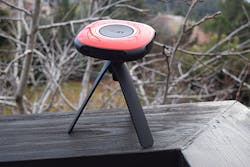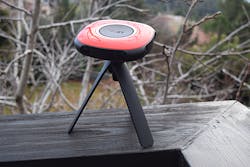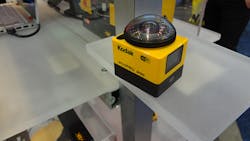New Cameras and Apps Drive Augmented and Virtual Reality
At the 2016 Consumer Electronics Show and since then, there have been hordes of people wearing funny goggles, waving their hands or pointing to something only they can see. Welcome to the world of augmented reality (AG) and virtual reality (VR). The advent of eye-based, high-resolution mobile displays is upon us and it is going to change the way we look at the world, real and imaginary.
Facebook’s Oculus Rift is an example of virtual-reality goggles that provide an immersive environment where all visual feedback is through the goggles. Head tracking is critical to the presentation for gaming where VR is popular, especially when combined with other tools like the Virtuix Omni or Kat Walk treadmill.
Microsoft’s HoloLens is an example of AR goggles (Fig. 1). AR adds to what a person normally sees. It can be used for gaming, but there are many other AR applications. It provides a heads-up display that can show general information or location/viewing information based on a person’s current location. Some applications synchronize the view with objects in the view allowing overlays such as training or support information.
Many AR and VR applications are being made more practical with 360-deg. cameras. The Vuze VR Camera (Fig. 2) can record 360-deg. HD video streams simultaneously from eight cameras spaced around the unit. It can record to an SD flash card for an hour. Each camera has an ultra-wide and vertical angle lenses to capture 120-deg. horizontal and 180-deg. vertical images. The videos are knitted together to create a 4K resolution, 360-deg. video. The cameras have overlapping coverage to provide stereoscopic videos.
The $449 Kodak PIXPRO SP360 Action Camera records a 360-deg. hemisphere with a 1080p resolution (Fig. 3). A 4K version is also available. The SP360 uses a single, 16 Mpixel camera and an interesting curved, spherical lens. It records at 10 frames/s. The battery-operated camera can record at 1080p for 160 minutes. The camera records to a microSD card or via the wireless 802.11n support.
What is very interesting about the SP360 is that two can be paired and synchronized to provide a recording sphere. They do not have to be adjacent to each other to do this. For example, one can be placed on top of a quadcopter and the other on the bottom so the recorded video does not show the quadcopter in the video. The magic is done by the post-production knitting software.
Not all AR/VR applications need recorded video, but many do. This may eventually be the norm in the same way that smartphones have replaced cameras and camcorders for most users. The PIXPRO SP360 and Vuze VR are just two of a growing number of similar cameras. Likewise, the Oculus Rift and HoloLens are just two of a similar growing family of VR and AR goggles. The best is yet to come.
About the Author
William Wong Blog
Senior Content Director
Bill's latest articles are listed on this author page, William G. Wong.
Bill Wong covers Digital, Embedded, Systems and Software topics at Electronic Design. He writes a number of columns, including Lab Bench and alt.embedded, plus Bill's Workbench hands-on column. Bill is a Georgia Tech alumni with a B.S in Electrical Engineering and a master's degree in computer science for Rutgers, The State University of New Jersey.
He has written a dozen books and was the first Director of PC Labs at PC Magazine. He has worked in the computer and publication industry for almost 40 years and has been with Electronic Design since 2000. He helps run the Mercer Science and Engineering Fair in Mercer County, NJ.
- Check out more articles by Bill Wong on Electronic Design
- Bill Wong on Facebook
- @AltEmbedded on Twitter



